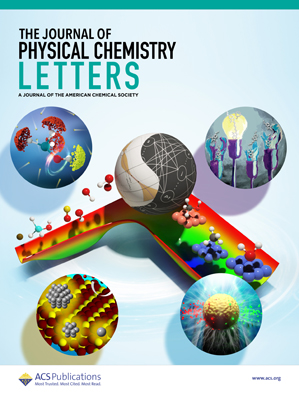通过交界往复法计算 MoS2/MoS2-MoO2 梯度复合材料中的安培塞贝克系数
IF 4.6
2区 化学
Q2 CHEMISTRY, PHYSICAL
引用次数: 0
摘要
我们通过双区化学气相传输(CVT)技术,制造出了从 MoS2 到 MoS2-MoO2 的径向转化生长。在薄膜的两个边缘施加热量(即热交界(TH))的想法具有明显的极性塞贝克系数(S),MoS2 作为热交界时为 -20 μVK-1,MoS2-MoO2 作为热交界时为 69.5 μVK-1。MoS2-MoO2 的 S 值为正值,表明在较低的界面费米级钉销程度下,空穴注入速度较快,并且通过各区域界面上的多个势垒中的低能载流子散射,在结点处产生了较大的不对称性。与 MoS2 相比,ΘD 在 5 K 左右有所降低,这表明 MoS2-MoO2 的化学键强度降低导致晶格软化。报告提出了在热电应用中利用薄膜分级复合材料的多重势垒的可能性。本文章由计算机程序翻译,如有差异,请以英文原文为准。

Ambipolar Seebeck Coefficient in MoS2/MoS2–MoO2 Graded Composites by Junction Reciprocation
We fabricated radially transformed growth of MoS2 to MoS2–MoO2 by the two-zone chemical vapor transport (CVT) technique. The idea to apply heat, i.e., hot junction (TH), on both the edges of the film has a distinct ambipolar Seebeck coefficient (S) of −20 μVK–1 with MoS2 as hot junction, and 69.5 μVK–1 with MoS2–MoO2 as hot junction. The positive S at MoS2–MoO2 indicates fast hole injection at a lower degree of interface Fermi-level pinning and large asymmetry at the junctions through low energy carrier scattering in the multiple potential barriers at the interfaces of each region. The decreased ΘD around 5 K than MoS2 reveals the lattice softening due to reduced strength of chemical bonding at MoS2–MoO2. The report propounds the potential utilization of multiple potential barriers for thin film graded composites in thermoelectric applications.
求助全文
通过发布文献求助,成功后即可免费获取论文全文。
去求助
来源期刊

The Journal of Physical Chemistry Letters
CHEMISTRY, PHYSICAL-NANOSCIENCE & NANOTECHNOLOGY
CiteScore
9.60
自引率
7.00%
发文量
1519
审稿时长
1.6 months
期刊介绍:
The Journal of Physical Chemistry (JPC) Letters is devoted to reporting new and original experimental and theoretical basic research of interest to physical chemists, biophysical chemists, chemical physicists, physicists, material scientists, and engineers. An important criterion for acceptance is that the paper reports a significant scientific advance and/or physical insight such that rapid publication is essential. Two issues of JPC Letters are published each month.
 求助内容:
求助内容: 应助结果提醒方式:
应助结果提醒方式:


